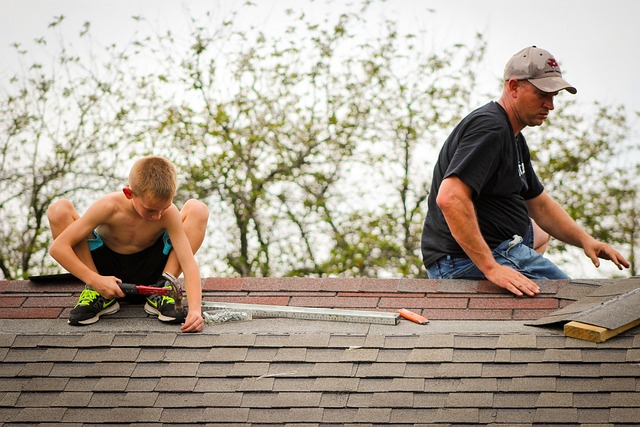Discover the transformative power of durable, attractive green roof designs – a harmonious blend of nature and architecture. This article explores the growing trend of eco-friendly roof gardens, delving into their environmental benefits and aesthetic appeal. We’ll guide you through key design elements, sustainable materials, and practical considerations, empowering you to navigate this vibrant, eco-conscious landscape. From understanding the fundamentals to unlocking the full potential, get ready to embrace a greener horizon.
- Understanding Green Roofs: The Eco-Friendly Revolution
- Design Elements for an Attractive Green Roof Garden
- Sustainable Materials and Systems for Longevity
- Benefits and Considerations for Implementing Green Roofs
Understanding Green Roofs: The Eco-Friendly Revolution
Green roofs, also known as eco-friendly roof gardens, are transforming urban landscapes and offering a sustainable solution for both environmental and aesthetic purposes. This innovative approach involves planting and growing vegetation on rooftops, providing a natural haven in an otherwise concrete jungle. The concept is simple yet powerful: by covering roofs with layers of soil and plants, these green spaces offer numerous benefits to the surrounding environment.
The eco-friendly roof garden movement has gained momentum due to its ability to mitigate urban heat islands, improve air quality, and provide insulation for buildings. Moreover, they contribute to biodiversity by creating habitats for various plant and animal species, enhancing the city’s natural beauty. With careful design and planning, green roofs can be attractive features that add value to properties while promoting a more sustainable and harmonious relationship between cities and nature.
Design Elements for an Attractive Green Roof Garden
Creating an attractive green roof garden involves a thoughtful blend of aesthetics and functionality, ensuring both visual appeal and environmental benefits. Key design elements include selecting suitable plants native to your region that can thrive in diverse weather conditions, incorporating various heights and textures through a mix of shrubs, perennials, and grasses to add depth and visual interest. Curved and undulating lines can mimic natural landscapes, providing a dynamic contrast against the structure below.
Retaining walls and raised beds help define different zones within the roof garden, allowing for themed areas such as an herb garden or a butterfly haven. Incorporating water features like small fountains or birdbaths not only enhances the garden’s allure but also attracts beneficial wildlife. Lighting is another crucial aspect; energy-efficient LED lights can illuminate the garden at night, showcasing its beauty long after the sun sets, while strategically placed lighting can highlight specific plants and create a captivating ambiance.
Sustainable Materials and Systems for Longevity
When designing an eco-friendly roof garden, the choice of sustainable materials and systems plays a crucial role in ensuring longevity. Incorporating natural, locally sourced components like recycled plastics, wood from certified sustainable sources, and organic growing media not only reduces environmental impact but also enhances the roof’s durability. These materials are often lighter than traditional options, easing structural stress while providing superior insulation.
Additionally, utilizing efficient irrigation systems, such as drip irrigation or rainwater harvesting, ensures water conservation. Integrating native plant species adapted to local climates further reduces maintenance needs and promotes biodiversity. Together, these strategies contribute to a robust and vibrant green roof that is not only aesthetically pleasing but also environmentally responsible.
Benefits and Considerations for Implementing Green Roofs
Green roofs, also known as eco-friendly roof gardens, offer a wealth of benefits for both the environment and buildings they adorn. One of their primary advantages is their ability to enhance sustainability. By covering rooftops with vegetation, green roofs help insulate buildings, reducing energy consumption for heating and cooling. They also play a crucial role in water management by absorbing rainwater, which can then be slowly released into the sewer system, alleviating strain on urban drainage networks.
When considering a green roof design, several factors come into play. First, the structural integrity of the building must be assessed to ensure it can support the additional weight. The choice of plants is also vital; certain species are better suited for roof gardens due to their adaptability and low maintenance requirements. Additionally, irrigation systems should be designed to efficiently deliver water to the plants while minimizing waste, ensuring the eco-friendly nature of the roof garden.
Durable and attractive green roof designs offer a harmonious blend of aesthetics and sustainability, transforming urban landscapes into vibrant ecosystems. By understanding the key components outlined in this article—from design elements to sustainable materials and the myriad benefits—we can create eco-friendly roof gardens that not only enhance our living spaces but also contribute to a greener, healthier planet. Embracing this green revolution is a step towards a more environmentally conscious future.
